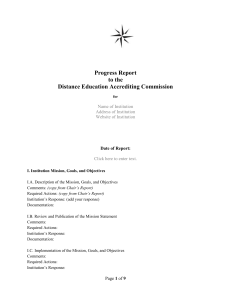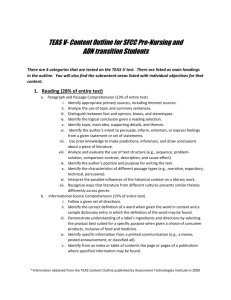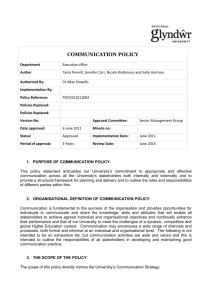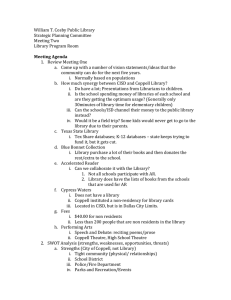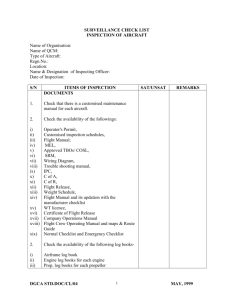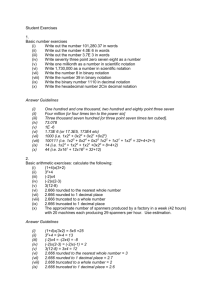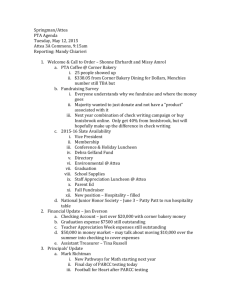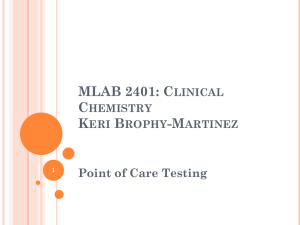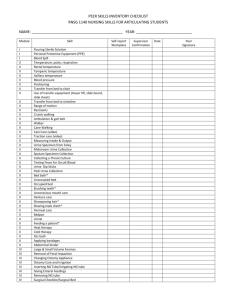Medical Assisting Competency Checklist | MAERB Core
advertisement
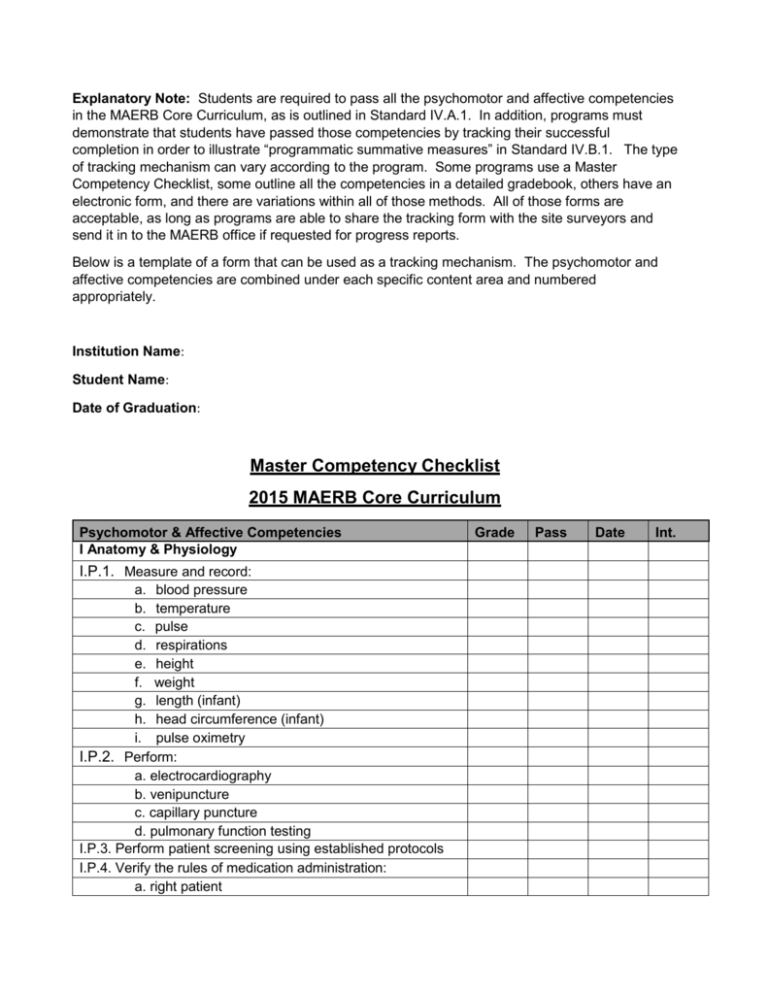
Explanatory Note: Students are required to pass all the psychomotor and affective competencies in the MAERB Core Curriculum, as is outlined in Standard IV.A.1. In addition, programs must demonstrate that students have passed those competencies by tracking their successful completion in order to illustrate “programmatic summative measures” in Standard IV.B.1. The type of tracking mechanism can vary according to the program. Some programs use a Master Competency Checklist, some outline all the competencies in a detailed gradebook, others have an electronic form, and there are variations within all of those methods. All of those forms are acceptable, as long as programs are able to share the tracking form with the site surveyors and send it in to the MAERB office if requested for progress reports. Below is a template of a form that can be used as a tracking mechanism. The psychomotor and affective competencies are combined under each specific content area and numbered appropriately. Institution Name: Student Name: Date of Graduation: Master Competency Checklist 2015 MAERB Core Curriculum Psychomotor & Affective Competencies I Anatomy & Physiology I.P.1. Measure and record: a. blood pressure b. temperature c. pulse d. respirations e. height f. weight g. length (infant) h. head circumference (infant) i. pulse oximetry I.P.2. Perform: a. electrocardiography b. venipuncture c. capillary puncture d. pulmonary function testing I.P.3. Perform patient screening using established protocols I.P.4. Verify the rules of medication administration: a. right patient Grade Pass Date Int. b. right medication c. right dose d. right route e. right time f. right documentation I.P.5. Select proper sites for administering parenteral medication I.P.6. Administer oral medications I.P.7. Administer parenteral (excluding IV) medications I.P.8. Instruct and prepare a patient for a procedure or a treatment I.P.9. Assist provider with a patient exam I.P.10. Perform a quality control measure I.P.11. Obtain specimens and perform: a. CLIA waived hematology test b. CLIA waived chemistry test c. CLIA waived urinalysis d. CLIA waived immunology test e. CLIA waived microbiology test I.P.12. Produce up-to-date documentation of provider/professional level CPR I.P.13. Perform first aid procedures for: a. bleeding b. diabetic coma or insulin shock c. fractures d. seizures e. shock f. syncope I.A.1. Incorporate critical thinking skills when performing patient assessment I.A.2. Incorporate critical thinking skills when performing patient care I.A.3. Show awareness of a patient’s concerns related to the procedure being performed II Applied Mathematics II.P.1. Calculate proper dosages of medication for administration II.P.2. Differentiate between normal and abnormal test results II.P.3. Maintain lab test results using flow sheets II.P.4. Document on a growth chart II.A.1. Reassure a patient of the accuracy of the test results III Infection Control III.P.1. Participate in bloodborne pathogen training III.P.2. Select appropriate barrier/personal protective equipment (PPE) III.P.3. Perform handwashing III.P.4. Prepare items for autoclaving III.P.5. Perform sterilization procedures III.P.6. Prepare a sterile field III.P.7. Perform within a sterile field III.P.8. Perform wound care III.P.9. Perform dressing change III.P.10. Demonstrate proper disposal of biohazardous material a. sharps b. regulated wastes III.A.1. Recognize the implications for failure to comply with Center for Disease Control (CDC) regulations in healthcare settings IV Nutrition IV.P.1. Instruct a patient according to patient’s special dietary needs IV.A.1. Show awareness of patient’s concerns regarding a dietary change V Concepts of Effective Communication V.P.1. Use feedback techniques to obtain patient information including: a. reflection b. restatement c. clarification V.P.2. Respond to nonverbal communication V.P.3. Use medical terminology correctly and pronounced accurately to communicate information to providers and patients V.P.4. Coach patients regarding: a. office policies b. health maintenance c. disease prevention d. treatment plan V.P.5. Coach patients appropriately considering: a. cultural diversity b. developmental life stage c. communication barriers V.P.6. Demonstrate professional telephone techniques V.P.7. Document telephone messages accurately V.P.8. Compose professional correspondence utilizing electronic technology V.P.9. Develop a current list of community resources related to patients’ healthcare needs V.P.10. Facilitate referrals to community resources in the role of a patient navigator V.P.11. Report relevant information concisely and accurately V.A.1. Demonstrate: a. empathy b. active listening c. nonverbal communication V.A.2. Demonstrate the principles of self-boundaries V.A.3. Demonstrate respect for individual diversity including: a. gender b. race c. religion d. age e. economic status f. appearance V.A.4. Explain to a patient the rationale for performance of a procedure VI Administrative Functions VI.P.1. Manage appointment schedule using established priorities VI.P.2. Schedule a patient procedure VI.P.3. Create a patient’s medical record VI.P.4. Organize a patient’s medical record VI.P.5. File patient medical records VI.P.6. Utilize an EMR VI.P.7. Input patient data utilizing a practice management system VI.P.8. Perform routine maintenance of administrative or clinical equipment VI.P.9. Perform an inventory with documentation VI.A.1. Display sensitivity when managing appointments VII Basic Practice Finances VII.P.1. Perform accounts receivable procedures to patient accounts including posting: a. charges b. payments c. adjustments VII.P.2. Prepare a bank deposit VII.P.3. Obtain accurate patient billing information VII.P.4. Inform a patient of financial obligations for services rendered VII.A.1. Demonstrate professionalism when discussing patient's billing record VII.A.2. Display sensitivity when requesting payment for services rendered VIII Third Party Reimbursement VIII.P.1. Interpret information on an insurance card VIII.P.2. Verify eligibility for services including documentation VIII.P.3. Obtain precertification or preauthorization including documentation VIII.P.4. Complete an insurance claim form VIII.A.1. Interact professionally with third party representatives VIII.A.2. Display tactful behavior when communicating with medical providers regarding third party requirements VIII.A.3. Show sensitivity when communicating with patients regarding third party requirements IX Procedural and Diagnostic Coding IX.P.1. Perform procedural coding IX.P.2. Perform diagnostic coding IX.P.3. Utilize medical necessity guidelines IX.A.1. Utilize tactful communication skills with medical providers to ensure accurate code selection X Legal Implications X.P.1. Locate a state’s legal scope of practice for medical assistants X.P.2. Apply HIPAA rules in regard to: a. privacy b. release of information X.P.3. Document patient care accurately in the medical record X.P.4. Apply the Patient’s Bill of Rights as it relates to: a. choice of treatment b. consent for treatment c. refusal of treatment X.P.5. Perform compliance reporting based on public health statutes X.P.6. Report an illegal activity in the healthcare setting following proper protocol X.P.7. Complete an incident report related to an error in patient care X.A.1. Demonstrate sensitivity to patient rights X.A.2. Protect the integrity of the medical record XI Ethical Considerations XI.P.1. Develop a plan for separation of personal and professional ethics XI.P.2. Demonstrate appropriate response(s) to ethical issues XI.A.1. Recognize the impact personal ethics and morals have on the delivery of healthcare XII Protective Practices XII.1. Comply with: a. safety signs b. symbols c. labels XII.2. Demonstrate proper use of: a. eyewash equipment b. fire extinguishers c. sharps disposal containers XII.3. Use proper body mechanics XII.4. Participate in a mock exposure event with documentation of specific steps XII.5. Evaluate the work environment to identify unsafe working conditions XII.A.1. Recognize the physical and emotional effects on persons involved in an emergency situation XII.A.2. Demonstrate self-awareness in responding to an emergency situation
